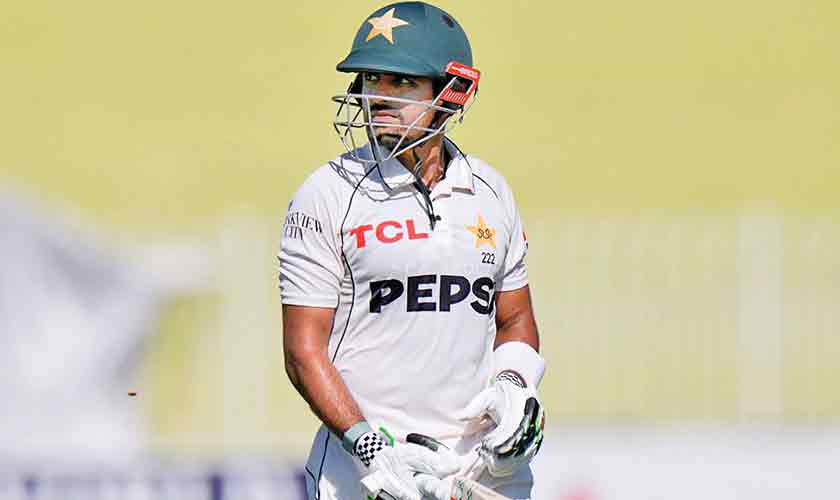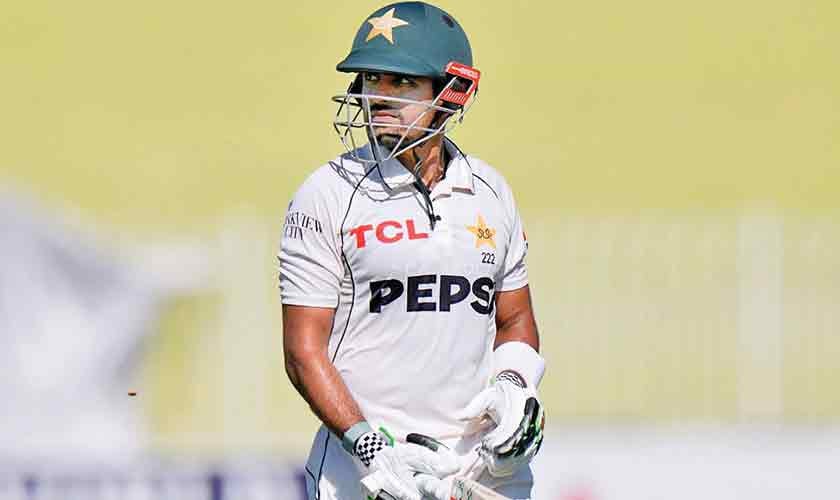
After the retirement of great Inzamam-ul-Haq, Mohammad Yousuf and Younis Khan who shared Pakistan batting burden for more than a decade, Babar Azam is the only batsman who cements his place in the middle-order.
Since then, Babar Azam has been the cornerstone of Pakistan’s batting lineup, his elegant stroke-play and impeccable technique earning him a place among the world’s elite batsmen.
Yet, as his form wanes in 2025, questions loom over his place in the team and whether Pakistan’s selectors can afford to drop their biggest star. The dilemma is stark: stick with a proven but underperforming asset, or gamble on unproven talent?
The statistics paint a worrying picture of Babar’s recent struggles. In the early stages of the Pakistan Super League (PSL) 2025, he registered a series of uncharacteristically low scores, including scores of 0, 1, and 2 in consecutive T20 matches.
This dip in form continued into international cricket. During the ODI tri-series in February 2025, he managed just 62 runs in three matches at a sub-par average of 20.67.
Similarly, his tour of the West Indies in August 2025 saw him post scores of 47, 0, and 9 in the three-match ODI series. While these figures are a temporary blip on an otherwise stellar career, they indicate a player struggling for confidence and rhythm.
He was dropped from the Asia Cup 2025, as head coach Mike Hesson described the exclusion of Babar as “Tough decision” acknowledging the right-hander’s stature but underlining the need for improvement.
Babar has been informed of the selectors’; decision. The team requires him to enhance his strike rate and strengthen his game against spin,” Hesson said.
The decision comes in the aftermath of Pakistan’s early elimination from the 2024 T20 World Cup, which followed their humbling defeat in the 2022 final. Statistics underline the concern: since 2020, Pakistan’s top three batters have faced nearly three-quarters of the Team’s deliveries-the highest proportion among full-member nations.
The hesitation to drop a player of Babar’s calibre is understandable. His career statistics are staggering, particularly his ODI average of 54.23, which places him among the very best in the format. He also holds impressive T20I (39.83) and Test (42.87) averages, cementing his status as a premier multi-format batsman.
However, with Pakistan team’s performances coming under increasing scrutiny, particularly following disappointing showings in global tournaments, relying on past glories is a luxury the selectors may not have.
Babar Azam, Pakistan’s star batsman and former captain, has recently been experiencing a decline in form, raising concerns among fans and cricket experts alike. His consistent performances over the years have been the backbone of Pakistan’s batting lineup, making his current struggles a significant challenge for the team. Despite his poor form, there is a notable lack of suitable replacements within the current squad.
Several emerging players have shown promise, but none have yet demonstrated the consistency or resilience needed to fill Babar’s shoes at the international level.
The team management is caught in a dilemma—while they recognise the need for a strategic change, they are hesitant to replace a crucial player without a dependable alternative.
This situation underscores the depth issues within Pakistan’s cricket pipeline and highlights the difficulty in finding someone who can match Babar’s skill, temperament, and leadership qualities.
The absence of a clear successor puts additional pressure on the squad and coaching staff, especially during important series. It also emphasises the importance of nurturing young talent and ensuring a smooth transition when experienced players face a dip in form. For now, Pakistan continues to hope that Babar Azam regains his top form, but the search for his effective replacement remains a pressing concern.
The debate surrounding Babar Azam’s form and future is a microcosm of Pakistan cricket’s enduring selection challenges. Dropping him carries the risk of losing a world-class anchor, while keeping him in poor form could jeopardise the team’s balance and results.
The selectors must weigh statistical evidence against his track record, all while navigating the political pressures that swirl around Pakistan cricket. For now, the question of who could possibly replace Babar remains a complex puzzle with no easy solution.
In Pakistan cricket, Babar Azam stands as a cornerstone of the batting lineup, his consistent performances with the bat have been instrumental in Pakistan’s pursuit of victory in numerous international matches. Despite occasional criticism over his strike rate, Babar’s technique, calmness under pressure, and ability to stabilise hi innings make him somewhat irreplaceable.
Currently, there is no viable replacement for Babar Azam in Pakistan’s middle-order especially in the longer version of the game. The depth of talent required to fill his shoes is lacking, as no emerging or established cricketer has demonstrated the same level of consistency and composure. The team management recognizes his importance, not only as a prolific run-scorer but also as a leader who guides younger players.
Investing in Babar Azam’s role remains crucial for Pakistan’s future success. Removing him from the team at this stage would risk destabilising the batting order and could hinder the team’s performance in upcoming series and tournaments.
With cricketing strategists emphasising stability and experience, Babar Azam’s position is secure — at least for now — as Pakistan’s most vital middle-order batsman.
Babar has seen a dip in his batting form across all formats and has failed to score an international fifty in his last 10 innings.
Babar stepped down as captain of all three formats last year after Pakistan failed to make the knockout stage of the ICC Cricket World Cup in India, before returning as white-ball skipper in March ahead of the ICC T20 World Cup in the United States (USA) and West Indies, where Pakistan did not make it past the opening group stage.
Pakistan won just six of the 13 Twenty20 international (T20I) matches they played under Babar in his second stint. Pakistan have not played a one-day international (ODI) match since the 2023 World Cup.
Babar’s past captaincy record speaks for itself. Under his leadership, Pakistan beat India for the first time in a World Cup encounter back in the ICC T20 World Cup 2021. In the 2022 T20 World Cup, he led the team to the final. This was Pakistan’s first final in a World Cup since 2009.
In T20Is, he has led the team 71 times, winning 42. This includes two final losses, in the Asia Cup and the World Cup, and a semi-final loss in the 2021 World Cup.
There is no doubt that Babar is a much better player than captain. Babar should learn how to change batting order and bowling plans according to the situation. He is still in the learning process of the art of leadership, especially in crunch moments.
Babar has struggled to maintain his form, particularly in Test cricket. His performance in the home Test series against Bangladesh was particularly disappointing, wherein he managed only 64 runs (0, 22, 11, and 31) across four innings.
He has not scored a half-century in his last 16 Test innings. Adding to the pressure, Babar fell from the ICC top 10 rankings for batters for the first time in years. However Babar’s solid and timely knock of 42 as top-scorer in Pakistan’s second innings in first Test against South Africa seems a good omen.
Pakistan’s overall decline in Test cricket has also mirrored Babar’s struggles. The team recently dropped to eighth place in the ICC Test Team Ranking.
khurrams87@yahoo.com
